The revival of out-of-home advertising in 2019 and how traditional mediums are shaping the future of marketing
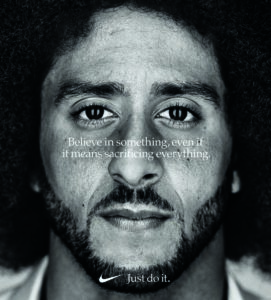 In the era of internet advertising, brands are coming at us from every direction, every platform and every avenue. From cookies that are smarter than we could have ever imagined to apps that know you better than you know yourself, the majority of advertising is always on the move, following us wherever we go. Yet, the most static form of advertising is having a revival, and succeeding in capturing our limited attention.
In the era of internet advertising, brands are coming at us from every direction, every platform and every avenue. From cookies that are smarter than we could have ever imagined to apps that know you better than you know yourself, the majority of advertising is always on the move, following us wherever we go. Yet, the most static form of advertising is having a revival, and succeeding in capturing our limited attention.
A seemingly retro ad format — “out-of-home advertising” — was expected to reach $28 billion last year, up 35 percent since 2010, according to data from ad measurement company Zenith.
“That’s the fastest-growing non-internet ad media besides cinema, which is drastically smaller — making percentage gains easier — and where the growth is mostly in China. Out-of-home ads, which make up 7 percent of total ad spending, have outperformed the rest of non-internet media, including TV, for the past six years.”
– Rani Molla, Journalist for Recode
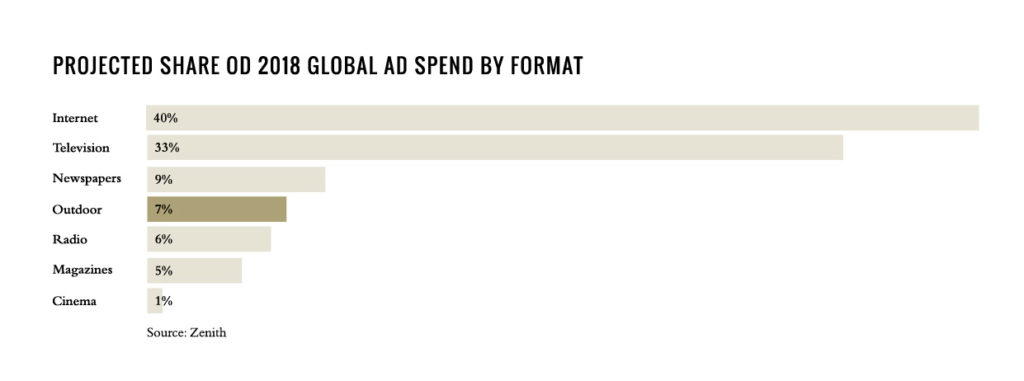
Why the growth now?
Many believe outdoor advertising is booming because digital advertising is so highly prevalent. With so much noise in the marketplace, a physical advertisement in a highly-trafficked location is a guaranteed way to reach a wide range of consumers.
Plus, everything we’re learning from digital technology is advancing the outdoor ad industry all together. With our mobile phones providing so much data about where we are and when, ad buyers can better understand how many people are walking by the ad, their demographics and their decision to make a purchase afterward.
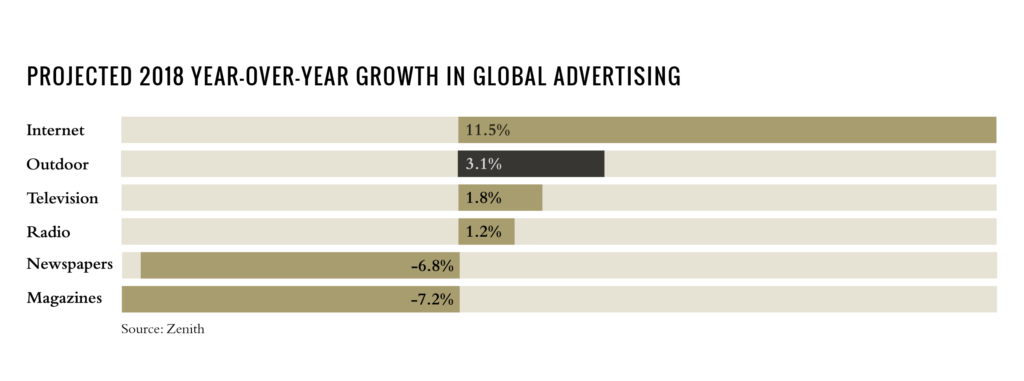
Who’s running the show?
It’s no surprise that the top U.S. spenders in the format last year included McDonalds, Chevrolet and Coca-Cola. What is news, however, is that those companies are no longer just the clients, but the owners. Netflix, which was already a heavy billboard advertiser, offered $300 million last year to acquire Los Angeles-based Regency Outdoor Advertising, according to Reuters. Supposedly the new strategy would keep all of the ads in house preventing the space from being rented by other companies. That would mean that ads for rivals AT&T’s HBO and CBS Corp’s Showtime, which currently promote shows on Regency billboards, would cycle off after the deal closed.
A defensive strategy, no doubt. Touché, Netflix.
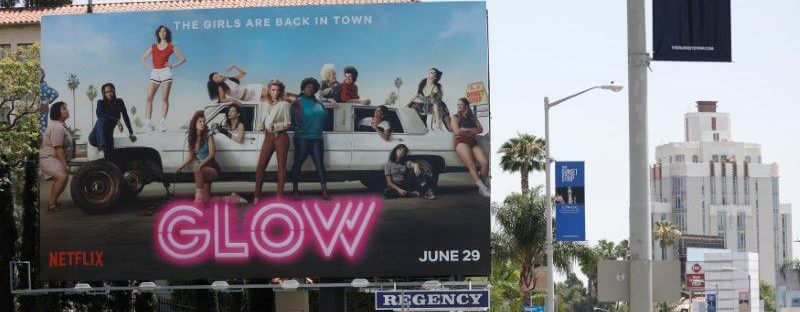
To be expected, speculation continues to rise that Google, and possibly other major tech players like Apple and Amazon, would begin to acquire out-of-home advertising assets. Rumor has it that last year Google engaged with German officials to introduce an advertising product for roadside billboards and other outdoor displays.
Though Google denied the report, advertising experts confirm that this would be the next logical step for the advertising giant who introduced the eponymous Google Ads.
“If the company entered this market, Google is going to hands down beat any other player just with the sheer number of advertisers that they already have. They already have the auction mechanism built up from the display ad framework.”
– Paul Hoban, Professor of Marketing, University of Wisconsin-Madison Business School
How are regulations around out-of-home advertising shifting?
Unlike other traditional forms, outdoor advertising faces restrictions from the federal, state and municipality levels as to how digital billboard ads change images and its frequency.
But as out-of-home advertising moves toward digital infrastructure and programmatic buying, it’s opening up political debate around when and where advertisers should be allowed to reach us. Ballyhoo Media recently fired up New York Gov. Andrew Cuomo for their flashy, floating digital billboards that the governor calls “a nuisance that blight our shores and distract from the great natural beauty of our waterways.” He has since signed legislation, but Ballyhoo doesn’t think the changes will prevent it from operating.
What does the future of outdoor advertising look like?
Direct-to-consumer brands represent one of the fastest growing verticals, likely because online brands are looking to find customers outside of internet silos. Brands like Glossier, Everlane and Homepolish are greeting us at bus stops, subway stations and in our city centers.
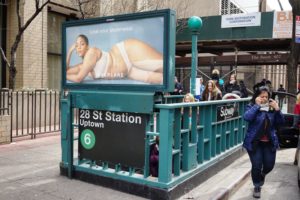
With larger budgets allocated to this media form, that means bigger brands are taking more creative approaches to getting their viewers’ attention. A few particularly innovative approaches include:
Harper Collins
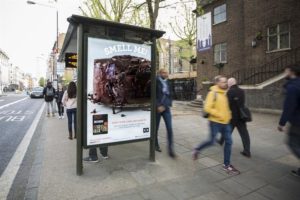 Some brands are going so far as to tantalize senses beyond sight to amplify the entire experience with the advertisement and convince consumers of the value of their product. HarperCollins’ scented billboard helps to sell a vegan cookbook:
Some brands are going so far as to tantalize senses beyond sight to amplify the entire experience with the advertisement and convince consumers of the value of their product. HarperCollins’ scented billboard helps to sell a vegan cookbook:
Coca-Cola
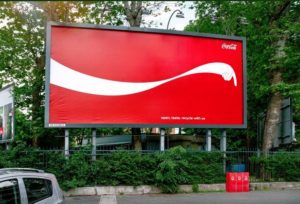 Some brands are folding in physical experiential elements to billboard placements to enhance the experience and create a deeper sense of engagement. Coca-Cola places recycling bins below its ads to literally point out the importance of recycling
Some brands are folding in physical experiential elements to billboard placements to enhance the experience and create a deeper sense of engagement. Coca-Cola places recycling bins below its ads to literally point out the importance of recycling
Utrecht
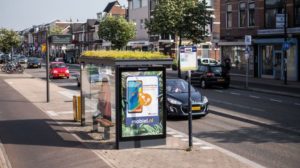 Other brands are working to make their advertisements feel less like ads all together, touting their creatiting and giving consumers a sneak peak into what it would feel like to engage with their brand. Utrecht beautifies the average city bus stop by creating a space that doubles as a habitat for bees and butterflies:
Other brands are working to make their advertisements feel less like ads all together, touting their creatiting and giving consumers a sneak peak into what it would feel like to engage with their brand. Utrecht beautifies the average city bus stop by creating a space that doubles as a habitat for bees and butterflies:
TYROLIT
 Some are going so far as to change the actual material of the advertisement to create a literal reason to believe in the brand, with physical proof of the product’s effectiveness. TYROLIT, a knife company, created a billboard on a metal that rusted over time in order to prove that it’s knives never rust:
Some are going so far as to change the actual material of the advertisement to create a literal reason to believe in the brand, with physical proof of the product’s effectiveness. TYROLIT, a knife company, created a billboard on a metal that rusted over time in order to prove that it’s knives never rust:
Illumination
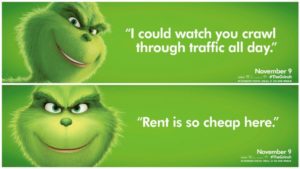 The Grinch Movie had an insight that consumers hate sitting in traffic (and often are in large cities), but love a bit of entertainment on their lengthy commutes. They did a geo-specific campaign that used billboards to call out the obvious flaws with different cities, roasting them just as the Grinch would:
The Grinch Movie had an insight that consumers hate sitting in traffic (and often are in large cities), but love a bit of entertainment on their lengthy commutes. They did a geo-specific campaign that used billboards to call out the obvious flaws with different cities, roasting them just as the Grinch would:
Can your brand convince a consumer to look up from their phone? Are you selling your product or service in a way that makes them stop in their tracks, or along their commute?